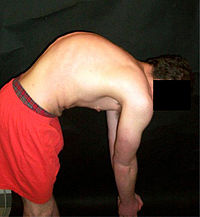
Photo from wikipedia
BACKGROUND Lumbar lordosis is required for bipedalism. OBJECTIVES To investigate age-related changes in lumbar lordosis and to clarify the relationships between lumbar lordosis and vertebral wedging and disc degeneration. METHODS… Click to show full abstract
BACKGROUND Lumbar lordosis is required for bipedalism. OBJECTIVES To investigate age-related changes in lumbar lordosis and to clarify the relationships between lumbar lordosis and vertebral wedging and disc degeneration. METHODS A total of 300 women were included in this retrospective study, 50 in each of six age groups (20-, 30-, 40-, 50-, 60- and 70-year-olds). Patients with vertebral collapse, instable fracture or disc sequestration were excluded. In each patient, lumbar lordosis angle, posterior vertebral wedging, L5-S1 intervertebral disc angle, L5/L1 vertebral height ratio and L5-S1 intervertebral disc/L1-L2 intervertebral disc height ratio were examined. Significance level was set at p< 0.05 and two-sided tests were used. RESULTS Significant differences were found in lumbar lordosis according to age group (p< 0.001). Lumbar lordosis correlated most strongly with L4 posterior vertebral wedging, L5 posterior vertebral wedging and L5-S1 intervertebral disc angle, in that order (r= 0.50, r= 0.40, r= 0.32, respectively; p< 0.001). CONCLUSION In this cohort, strong spinal structure was maintained during physiological aging from 20 to 40 years of age; lumbar lordosis increased by 50 years of age. Increased lordosis correlated with increased posterior vertebral wedging and loss of posterior disc height.
Journal Title: Journal of back and musculoskeletal rehabilitation
Year Published: 2017
Link to full text (if available)
Share on Social Media: Sign Up to like & get
recommendations!